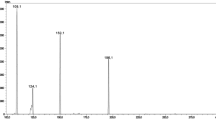Abstract
A liquid chromatography–electrospray ionization/tandem mass spectrometry method for the quantitation of psilocin in plasma is presented. Sample workup was performed with mixed-mode solid-phase extraction using ascorbic acid and nitrogen for drying to protect the unstable analyte. Calibration curves were linear from 2 to 100 ng/mL, and no selectivity problems occurred. The limit of detection was 0.1 ng/mL, and the limit of quantitation was 0.34 ng/mL. Recovery was >86% and matrix effects were <110%. Both were reproducible. Interday and intraday precisions at different concentrations were 1.5–4.3% relative standard deviation, bias within ±9%. Processed samples were stable in the autosampler for at least 26 h. Furthermore, the stability of psilocin in blood stored at different temperatures over various periods of time was investigated. Samples stored at room temperature showed a continuous decrease of analyte leading to a loss of about 90% after 1 week. Storage in the fridge improved sample stability significantly. Freezing of blood samples led to a not reproducible loss of psilocin.


Similar content being viewed by others

References
Hofmann A, Heim R, Brack A, Kobel H, Frey A, Ott H, Petrzilka T, Troxler F (1959) Psilocybin und Psilocin, zwei psychotrope Wirkstoffe aus mexikanischen Rauschpilzen. Helv Chim Acta 42:1557–1572
Geschwinde T (2003) Rauschdrogen, Marktformen und Wirkungsweisen. Springer, Berlin
European Monitoring Centre for Drugs and Drug Addiction (2006) EMCDDA thematic papers—hallucinogenic mushrooms: an emerging trend case study. http://www.emcdda.europa.eu/attachements.cfm/att_31215_EN_TP_Hallucinogenic_mushrooms.pdf. Accessed 13 Jul 2011
Horita A, Weber LJ (1961) The enzymic dephosphorylation and oxidation of psilocybin and psilocin by mammalian tissue homogenates. Biochem Pharmacol 7:47–54
Hasler F, Bourquin D, Brenneisen R, Bär T, Vollenweider FX (1997) Determination of psilocin and 4-hydroxyindole-3-acetic acid in plasma by HPLC-ECD and pharmacokinetic profiles of oral and intravenous psilocybin in man. Pharm Acta Helv 72:175–184
Holzmann P (1995) Bestimmung von Psilocybin-Metaboliten im Humanplasma und -urin. Eberhard-Karls-Universität, Dissertation
Hasler F, Bourquin D, Brenneisen R, Vollenweider FX (2002) Renal excretion profiles of psilocin following oral administration of psilocybin: a controlled study in man. J Pharm Biomed Anal 30:331–339
Lindenblatt H, Krämer E, Holzmann-Erens P, Gouzoulis-Mayfrank E, Kovar K (1998) Quantitation of psilocin in human plasma by high-performance liquid chromatography and electrochemical detection: comparison of liquid–liquid extraction with automated on-line solid-phase extraction. Journal of Chromatography B: Biomedical Sciences and Applications 709:255–263
Grieshaber AF, Moore KA, Levine B (2001) The detection of psilocin in human urine. J Forensic Sci 46:627–630
Albers C, Köhler H, Lehr M, Brinkmann B, Beike J (2004) Development of a psilocin immunoassay for serum and blood samples. Int J Legal Med 118:326–331
Kamata T, Nishikawa M, Katagi M, Tsuchihashi H (2003) Optimized glucuronide hydrolysis for the detection of psilocin in human urine samples. J Chromatogr B 796:421–427
Kamata T, Nishikawa M, Katagi M, Tsuchihashi H (2006) Direct detection of serum psilocin glucuronide by LC/MS and LC/MS/MS: time-courses of total and free (unconjugated) psilocin concentrations in serum specimens of a “magic mushroom” user. Forensic Toxicol 24:36–40
del Mar Ramirez Fernandez M, Laloup M, Wood M, De Boeck G, Lopez-Rivadulla M, Wallemacq P, Samyn N (2007) Liquid chromatography–tandem mass spectrometry method for the simultaneous analysis of multiple hallucinogens, chlorpheniramine, ketamine, ritalinic acid, and metabolites, in urine. J Anal Toxicol 31:497–504
Björnstad K, Beck O, Helander A (2009) A multi-component LC–MS/MS method for detection of ten plant-derived psychoactive substances in urine. J Chromatogr B 877:1162–1168
Saito K, Toyo’oka T, Fukushima T, Kato M, Shirota O, Goda Y (2004) Determination of psilocin in magic mushrooms and rat plasma by liquid chromatography with fluorimetry and electrospray ionization mass spectrometry. Anal Chim Acta 527:149–156
Sticht G, Käferstein H (2000) Detection of psilocin in body fluids. Forensic Sci Int 113:403–407
Bogusz MJ (2000) Liquid chromatography–mass spectrometry as a routine method in forensic sciences: a proof of maturity. J Chromatogr B 748:3–19
Tiscione NB, Miller MI (2006) Psilocin identified in a DUID investigation. J Anal Toxicol 30:342–345
Anastos N, Barnett NW, Pfeffer FM, Lewis SW (2006) Investigation into the temporal stability of aqueous standard solutions of psilocin and psilocybin using high performance liquid chromatography. Science & Justice 46:91–96
Peters F, Hartung M, Herbold M, Schmitt G, Daldrup T, Mußhoff F (2009) Anhang B zur Richtlinie der GTFCh zur Qualitätssicherung bei forensisch-toxikologischen Untersuchungen: Anforderungen an die Validierung von Analysenmethoden. Toxichem Krimtech 76:185–208
Conflict of interest
The authors declare that they have no conflict of interest.
Author information
Authors and Affiliations
Corresponding author
Rights and permissions
About this article
Cite this article
Martin, R., Schürenkamp, J., Pfeiffer, H. et al. A validated method for quantitation of psilocin in plasma by LC–MS/MS and study of stability. Int J Legal Med 126, 845–849 (2012). https://doi.org/10.1007/s00414-011-0652-8
Received:
Accepted:
Published:
Issue Date:
DOI: https://doi.org/10.1007/s00414-011-0652-8



